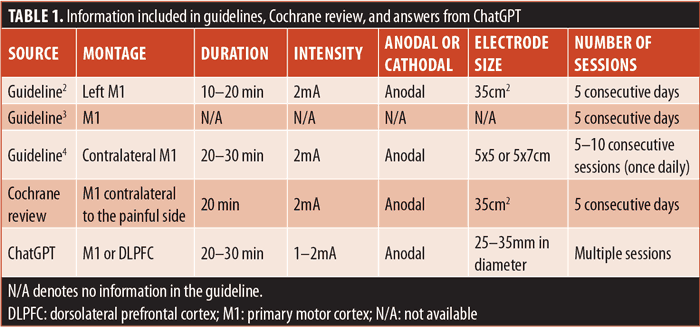
by Edson Silva-Filho, PhD, and Rodrigo Pegado, PhD
Both authors are with Graduate Program in Heath Science, Graduate Program in Physical Therapy, Federal University of Rio Grande do Norte in Rio Grande do Norte, Brazil. Dr. Pegado is additionally with Graduate Program in Rehabilitation Science, Federal University of Rio Grande do Norte in Rio Grande do Norte, Brazil.
Funding: No funding was provided for this article.
Disclosures: The authors have no conflicts of interest relevant to the contents of this article.
Innov Clin Neurosci. 2024;21(1–3):61–62.
Abstract
Objective: We aimed to open a discussion about the integration of artificial intelligence (AI) in science and clinical practice, specifically with regard to the use of transcranial direct current stimulation (tDCS) as a technique for managing chronic pain.
Main Points of Discussion: To analyze the responses generated by ChatGPT and the best literature about tDCS, we formulated three questions. The answers from ChatGPT, compared to the guidelines and Cochrane review, showed that AI can be a potential strategy to help clinicians and researchers. AI such as ChatGPT is revolutionizing the academic field and clinical practice. However, there is still an unmet scientific and clinical discussion about the insertion of AI to help researchers and clinicians in the neuromodulation area treat chronic pain.
Conclusion: We need to know the limits of the use of AI. Even though ChatGPT might be helpful, it should be used with caution in the academic field and clinical practice.
Keywords: Artificial intelligence, neuromodulation, transcranial direct current stimulation, pain
The field of science is experiencing a dynamic and impactful evolution. Novel methods for acquiring and generating knowledge have emerged and are aiding millions of users in resolving daily challenges. One such method is artificial intelligence (AI). This powerful tool has been integrated into numerous processes across a broad range of scientific disciplines. The widespread utilization of AI in both academic and industrial settings, as well as in everyday applications, has become a reality.
The new AI tool, ChatGPT, developed by OpenAIRM (San Francisco, California, USA), offers an interactive and personalized experience to users. ChatGPT is an artificial language model capable of generating human-like responses to various questions. This innovative tool has gained worldwide attention and is now widely utilized. However, the use of this new technology in the academic environment by researchers remains a topic of ongoing discussion. Currently, there are more than 1,000 articles available in the PubMed database on this subject. Writing in the scientific field could become simpler with the help of artificial models, but their responsible use should be deliberated. A few journals are modifying their licenses and editorial policies to clarify that texts produced by models, such as ChatGPT, will not be accepted. These journal updates explain that while AI may be used as a writing tool, it is considered plagiarism when the models generate content.1 Researchers and journals are keeping a watchful eye on the use of artificial models for writing articles. However, the use of models for gathering reliable information has not yet been fully considered.
AI models have the potential to revolutionize neuroscience and neuromodulation practices in the scientific and clinical domains. The onset of the COVID-19 pandemic contributed to a growing interest in remote interventions using Bluetooth-controlled transcranial direct current stimulation (tDCS) devices.2 Although implementing these interventions in clinical practice has been challenging, recent advances in device development and evidence-based research have made them more accessible to a wider audience.2
The use of tDCS for the treatment of chronic pain is well-established and recommended by several guidelines worldwide.3–5 These recommendations specify the appropriate montage, duration, intensity, electrode size, and number of sessions. While it is possible that this standard model might be modified in the future, it currently serves as the gold standard for chronic pain treatment.
Given these premises, it is of interest to explore the potential applications of ChatGPT in both academic and clinical settings. To this end, we selected three guidelines on tDCS and one Cochrane review for pain treatment published by renowned researchers in the field.3–6 To compare the responses generated by ChatGPT with the information provided in the guidelines and Cochrane review, we formulated three questions: 1) What is the cortical target recommended for tDCS in the context of chronic pain treatment? 2) How many sessions are required to generate therapeutic effects of tDCS for chronic pain? 3) What is the optimal tDCS montage for chronic pain treatment? The model provided correct suggestions about using tDCS for pain and affirmed that further research is needed. Table 1 summarizes the main results of the guidelines and Cochrane review and the answers from ChatGPT. We saw that it is possible for the model to generate objective and thorough information.

In conclusion, ChatGPT is an AI tool that can potentially generate enough information to aid decision-making in academic and clinical practice. However, it is important to note that ChatGPT is in constant update, and it is not a reliable source for finding scientific data. It is unlikely, but not impossible, that AI could substitute human beings in sciences and clinics. For now, we must be extremely cautious using this new model in any environment.
Author Contributions
ESF and RP wrote the main manuscript text and prepared Table 1. Both authors reviewed the manuscript.
References
- Thorp HH. ChatGPT is fun, but not an author. Science. 2023;379(6630):313.
- Bikson M, Hanlon CA, Woods AJ, et al. Guidelines for TMS/tES clinical services and research through the COVID-19 pandemic. Brain Stimul. 2020;13(4):1124–1149.
- Lefaucheur JP, Antal A, Ayache SS, et al. Evidence-based guidelines on the therapeutic use of transcranial direct current stimulation (tDCS). Clin Neurophysiol. 2017;128(1):56–92.
- Cruccu G, Garcia-Larrea L, Hansson P, et al. EAN guidelines on central neurostimulation therapy in chronic pain conditions. Eur J Neurol. 2016;23(10):1489–1499.
- Baptista AF, Fernandes AMBL, Sá KN, et al. Latin American and Caribbean consensus on noninvasive central nervous system neuromodulation for chronic pain management (LAC2-NIN-CP). Pain Rep. 2019;4(1):e692.
- O’Connell NE, Marston L, Spencer S, et al. Non-invasive brain stimulation techniques for chronic pain. Cochrane Database Syst Rev. 2018;4(4):CD008208.





